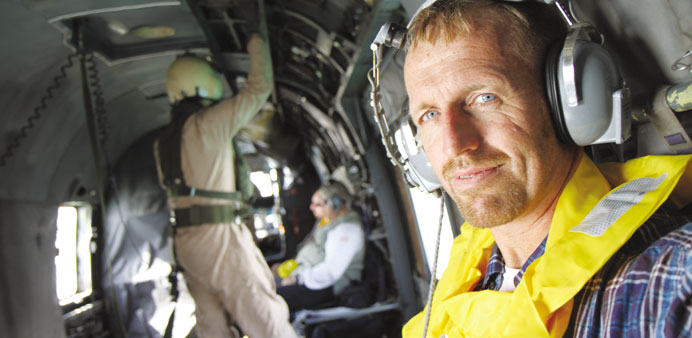Steffen Bach: ‘much to be discovered’
By Fran Gillespie/Doha
A packed audience listened enthralled on Wednesday evening to a scientist describing one of the most exciting wildlife discoveries to be made in Qatar in recent years.
The Qatar Natural History Group had invited marine biologist Steffen Bach from Maersk Oil Research Centre in Qatar to talk about the ongoing Qatar Whale Shark Research project (QWSR).
Describing how large groups of these huge animals aggregate each year near Maersk Oil’s platforms on the Al Shaheen Oil Field, some 80km offshore, Bach said, “Since the 1990s there had been stories by offshore workers of giant fish being seen during the warmer months.
“In 2007 Soren Stig, a production supervisor with Maersk Oil Qatar, took a photo of more than 100 whale sharks surrounding a platform and posted it on the Internet. But it wasn’t until 2010 that it became clear that something very exciting was happening there.”
David Robinson of Herriott-Watt University, the research team leader of QWSR, came across the photograph during his initial research for his doctoral thesis on whale sharks and made contact with the Ministry of the Environment.
Mohamed al-Jaidah at the Ministry quickly realised the importance of the discovery, and together they formed the Qatar Whale Shark Research Project in 2010. The Maersk Oil Research and Technology Centre joined the project in 2012. This is a story, said the speaker, of fruitful collaboration between industry, researchers and the Qatari authorities ultimately to support the Qatar National Vision 2030. Its aim is to study the biodiversity of the Al Shaheen area and to learn more about the mysterious lives of the colossal fish. Whale sharks (Rhincodon typus) are the largest fish species on the planet, some measuring as much as 18 metres in length, with dark grey skin covered with white star-like spots. They inhabit open water and feed almost entirely on plankton and microscopic plants and animals, scooping them up with their colossal gaping mouths.
There is still much to be discovered, said Bach. No one knows, for example, the life span of these enormous creatures. It may be as long as 60 or even 100 years, but studies have begun so recently that such figures can only be guessed at. Categorised as ‘vulnerable’ world-wide, they may be facing a decline in numbers, through fishing, pollution, loss of habitat, boat strikes and other causes.
The QWRS team regularly visits the Al Shaheen oil field in the summer months when the fish aggregate, and this would not be possible without the willing help of the Qatari Coast Guard. Even their fast boats take a couple of hours to reach the oil field, and when they arrive there is no guarantee that the team will see the sharks. Why do the sharks choose to aggregate in such large numbers in an area far from land? There are a number of possible reasons, said Bach. One reason could be that the oil platforms act as artificial reefs, like a marine oasis of life amidst the desert sea. The underwater structures are richly encrusted with a growth of soft corals and sponges, encouraging thousands of colourful fish to gather.
The scientists attach satellite tags to the fish in order to follow their movements. The researchers are keen to discover whether the whale sharks ever leave the Arabian Gulf and, if so, where they go.
The Qatar Air Force has also helped with the surveys, by taking aerial photographs from which the number of sharks can be estimated.
The Al Shaheen sharks swim unusually fast in comparison with whale sharks known in other parts of the world, and the camera crew filming the whale sharks experimented using small motors to help them keep with the sharks to film for a TV series that is to be launched this year.
Worldwide, individual whale sharks can be identified by their unique spot pattern. Each shark identified in Qatar is entered into the global database to see if the shark has previously been sighted elsewhere. Hopefully, the scientists will be able to discover whether sharks from the Indian Ocean populations ever visit the Gulf, and vice-versa.
The striking pattern of white spots on a dark grey background has caused the whale shark to be named ‘papa shillingi’ in Kenya through the resemblance of the spots to coins, ‘domino’ in Latin America, ‘many stars’ in Madagascar and ‘stars on the back’ in the Philippines.
The Qatar Ministry of Environment and QWSR project aims to provide a better understanding of the whale sharks in the Arabian Gulf so that the sight of this natural wonder can be preserved for generations to come.

